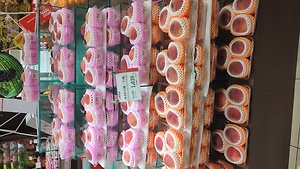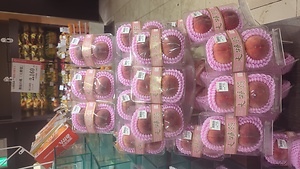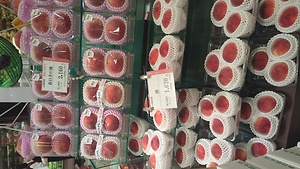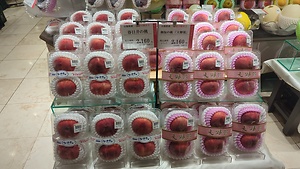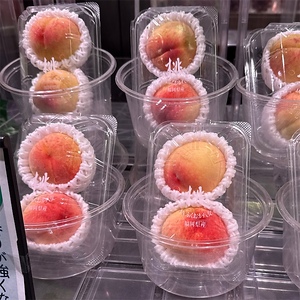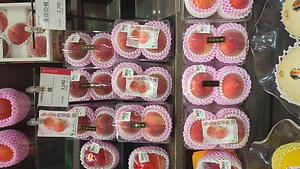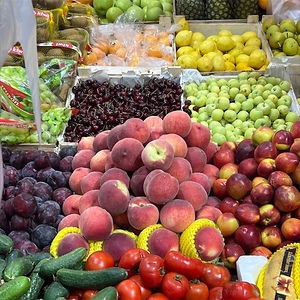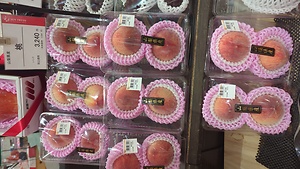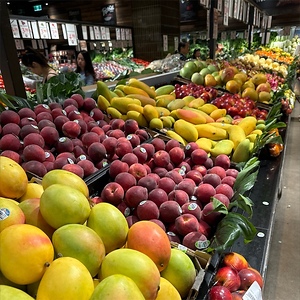

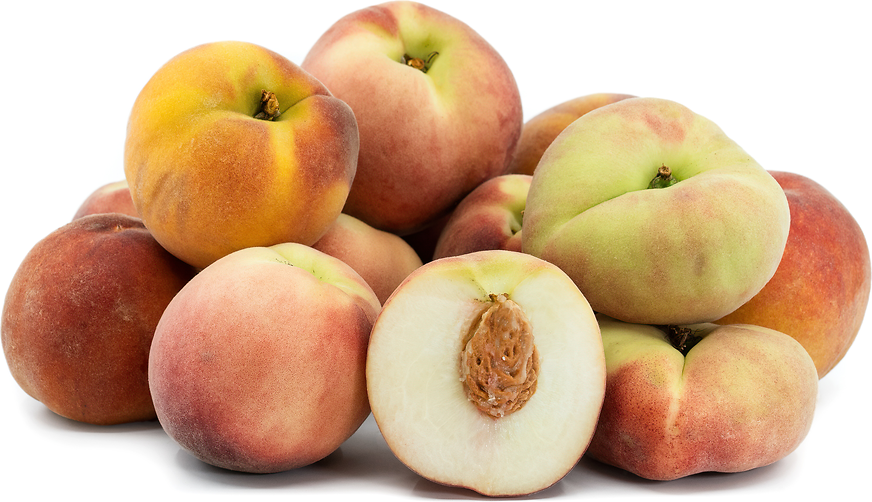
Peaches
Estimated Inventory, 18 lbs : 6.00
This item was last sold on : 07/04/25
Description/Taste
Peaches vary in size and appearance depending on the specific variety and growing conditions. They are found in round, oval, or flat saucer shapes and bear a prominent, indented seam extending the surface length. Peaches are distinguished from nectarines by their velvety, fuzz-coated skin. This downy layer gives the surface a soft, slightly textured feel. The skin is taut and typically thin, showcasing variegated red, pink, yellow, and ivory hues. Each variety will have a distinct coloring, and the red blush changes in saturation based on the sunlight received during cultivation. Peaches are delicate and can be easily bruised or damaged on their surface if handled roughly. Underneath the skin, the flesh ranges from white to golden yellow, and some types are flushed with crimson to red-pink coloration. Unripe Peaches are firm and hard, while ripe versions develop a soft, succulent, tender, and aqueous consistency. Some varieties will remain firmer than others, and each fruit envelops a central almond-shaped brown stone. Depending on the variety, the stone can either be easily removed from the flesh or tightly adhered. Select peaches free of green hues and release a honeyed, fruity, and lightly floral aroma. Ripe Peaches are edible raw or cooked and range in flavor based on the individual variety, with many showcasing sweet, sugary, tart, tangy, fruity, and floral flavors. White peaches tend to be slightly sweeter and lower in acid than yellow peaches, while yellow peaches have a stronger overall flavor.
Seasons/Availability
Peaches are in season during the summer, typically from late May through September. Peaches are also grown in both hemispheres, allowing for year-round availability in some commercial markets through imports and locally grown fruits.
Current Facts
Peaches, botanically classified as Prunus persica, are a category of stone fruits belonging to the Rosaceae family. It is estimated that there are over 2,000 varieties of peaches worldwide, and these cultivars are divided into three main types by their flesh coloring: yellow, white, and blood. Peaches are an ancient fruit that has been domesticated and continually improved for thousands of years. As new varieties have been created throughout history, peaches have been further organized into subgroups like freestone, clingstone, and semi-freestone fruits, indicating whether the flesh sticks to the central stone. There are also melting and non-melting types, pointing to the fruit’s overall consistency. Melting varieties are the most popular types sold in commercial markets for fresh-eating and represent the soft, succulent, and juicy ideals consumers generally associate with peaches. Non-melting types are primarily reserved for processing, especially for canning. In the present day, peaches are a broad category of fruits favored for their texture, aroma, and flavor. Within this overarching category, there are rare varieties that are hyperlocal to select communities worldwide and more widespread cultivars grown for mass production. Fresh-eating peach varieties are versatile and sought by chefs and home cooks for their ability to be used in both sweet and savory culinary preparations.
Nutritional Value
Peaches vary in vitamin and mineral content, depending on the specific variety. In general, the fruits are a source of vitamins A, C, E, and K to maintain healthy organs, strengthen the immune system, guard the cells against free radical damage, and aid in faster wound healing. Peaches also provide fiber to stimulate the digestive tract and minerals like potassium, calcium, copper, iron, magnesium, manganese, phosphorus, and zinc. Potassium balances fluid levels within the body, while calcium and phosphorus support bone and teeth development. Copper helps produce red blood cells, iron develops the protein hemoglobin for oxygen transport through the bloodstream, magnesium helps control nerve functions, while manganese assists in energy production. Peaches have acquired several symbolic meanings worldwide, especially in China. Peach blossoms are believed to protect against evil spirits and are a symbol of new beginnings and vitality. The flowers were revered for their ability to bloom before leaves sprouted on the trees each spring, and are placed around houses and businesses for their positive and protective connotations.
Applications
Peaches vary in flavor depending on the variety. Fresh-eating cultivars are ideal for raw and cooked preparations. Ripe, raw peaches can be eaten out of hand and are traditionally sliced into pieces and consumed in their entirety. Some consumers choose to peel the skin before eating, and this is primarily based on preference. Peaches can also be sliced for salads or used as a tomato substitute in a variation of caprese with mozzarella and basil. Try dicing the fruit into salsa or incorporating it into fruit medleys, grain bowls, and as a topping over parfaits. Peaches can also be sliced and dropped into sparkling wine, blended into smoothies or milkshakes, or pureed into flavoring cocktails. In addition to raw preparations, peaches are famously used in desserts and baked goods. Sweet peaches can be added to pies, crisps, cakes, and crumbles or simmered into syrups, jams, sauces, and compotes. In Italy, pesche dolci is a pastry made to look like a peach. Peaches are also frozen into sorbet and ice cream. Beyond sweet preparations, peaches can be utilized in savory dishes as glazes for roasted meats. They are also halved and grilled to develop a smoky, caramelized nuance or served alongside braised meats. Peaches pair well with herbs such as mint, thyme, rosemary, and basil, fruits such as berries, citrus, and other stone fruits, and nuts including almonds, pecans, and pistachios. Whole, unwashed peaches should be ripened at room temperature. The fruits should be immediately consumed once they have reached their desired maturity stage to ensure the best quality and flavor. Peaches will keep for a day or two in the fridge and can also be frozen for up to one year.
Ethnic/Cultural Info
Peaches are famous for their use in the classic cobbler dessert. It is thought that cobbler was developed during the American colonial period and was an adaptation of pies and other dessert recipes from Europe. Early settlers may not have had access to the ingredients once readily available to them, and improvised to create new recipes with the ingredients surrounding them. The first cobblers were served for breakfast or dinner rather than as a dessert, and peach cobblers were prevalent in the southern United States. The exact origins of the name cobbler are unknown, but several folkloric theories provide explanations. The two main tales involve deriving the name from the process of the recipe being cobbled together or from the thick crust at the top, sometimes resembling cobblestones. Peach cobbler is still enjoyed throughout the United States in the modern day, and one of the world’s largest peach cobblers is annually made at the Georgia Peach Festival. This event attracts over 10,000 visitors and celebrates the fruits grown in Peach County. The festival’s cobbler is said to span over eleven feet in length and requires 75 gallons of peaches. Once baked in a specialized brick oven built in the county’s courthouse parking lot, the cobbler can feed several thousand festival attendees.
Geography/History
Peaches are descendants of wild fruits native to China. Much of the history of early peach types is unknown, but the first domesticated fruits were thought to have arisen from the Yangzi River Valley in Southern China. Ancient peach stones have been discovered at several archaeological sites in China, indicating that the fruits have been cultivated since before the Common Era. Scientists believe it took several thousand years for peaches to transition from wild to domesticated types, and over time, peaches were spread along trade routes from Asia into the Middle East and Eastern Europe. Peaches were introduced into Western regions of Europe, mainly France and Spain, through Alexander the Great, who carried the seeds from Persia. Later in the 16th century, Spanish and French explorers introduced peaches to the New World and planted them at various stops, including along the Gulf coastal region and in Saint Augustine, Florida. Indigenous American people groups contributed to the spread of peaches throughout North America, and by the 17th century, colonial settlers were also planting peach trees in their gardens. Thomas Jefferson notably had over 1,100 peach trees on his Monticello Estate, and the fruits eventually became a symbol of the southern American states. Today, peaches are grown worldwide in commercial settings and home gardens. Fruits are seasonally found through local markets and are also imported for year-round availability in select supermarkets and retailers.
Featured Restaurants
Restaurants currently purchasing this product as an ingredient for their menu.
| Beach Terrance Inn | Carlsbad CA | 760-729-5951 |
| Farmer and The Seahorse | San Diego CA | 619-302-3682 |
| Bread & Cie Café | San Diego CA | 619-683-9322 |
| Little Frenchie | Coronado CA | 619-522-6890 |
| Parkhouse Eatery | San Diego CA | 619 295 7275 |
| Crown Point Catering | San Diego CA | 619-223-1211 |
| Claytons Bakery & Bistro | Coronado CA | 619-435-5425 |
| Reata Glen | Ladera Ranch CA | 949-545-2250 |
| DoubleTree By Hilton San Diego | San Diego CA | 619-881-6900 |
| The Corner Drafthouse | San Diego CA | 619-255-2631 |
| Cutwater Spirits | San Diego CA | 619-672-3848 |
| The Market by Buon Appetito | San Diego CA | 619-237-1335 |
| Beaumont's | San Diego CA | 858-459-0474 |
| Saiko Sushi-Coronado | Coronado CA | 619-435-0868 |
| Continental Catering Inc | La Mesa CA | 907-738-9264 |
| Firefly Beach | San Diego CA | 619-222-6440 |
| Solare Ristorante Lounge | San Diego CA | 619-270-9670 |
| Cliffhanger Cafe Menu | San Diego CA | 858-452-9858 |
| Javier Plascencia (Animalon) | Bonita CA | 619-295-3172 |
| Green Acres Campus | San Diego CA | 858-450-9907 |
| La Jolla Beach & Tennis Club | San Diego CA | 619-816-8319 |
| Bridges at Rancho Santa Fe | Rancho Santa Fe CA | 858-759-6063 |
| Candor | La Jolla CA | 858-581-2205 |
| Third Corner Encinitas | Encinitas CA | 760-942-2104 |
| Southwestern Yacht Club | San Diego CA | 619-222-0438 |
| Black Radish | San Diego CA | 619-775-7412 |
| Trattoria I Trulli | Encinitas CA | 760-277-9826 |
| South O Brewing Catering | Oceanside CA | 925-381-5392 |
| Noble House Hotels & Resorts | San Diego CA | 619-276-4010 |
| Slowly | San Diego CA | 858-352-6080 |
| Vertex - Merryfield Row | San Diego CA | 619-405-8950 |
| La Jolla Country Club | San Diego CA | 858-454-9601 |
| Piatti | San Diego CA | 858-454-1589 |
| Leila | San Diego CA | 619-550-5412 |
| Brockton Villa Restaurant | San Diego CA | 858-454-7393 |
| The Wild Thyme Company | San Diego CA | 858-527-0226 |
| Urban Kitchen Catering | San Diego CA | 619-276-8803 |
| Jake's Del Mar | Del Mar CA | 858-755-2002 |
| Bleu Boheme | San Diego CA | 619-255-4167 |
| Huntress | San Diego CA | 619-955-5750 |
| Wildflour | San Diego CA | 619-289-9240 |
| Shoreside Support Boat | San Diego CA | 704-277-7929 |
| Royal Polaris Sportfishing | San Diego CA | 619-226-8030 |
| Pacific Yacht Agents | Los Angeles CA | 808-214-0970 |
| Kingfisher | San Diego CA | 619-861-8074 |
| Nadolife Production | San Diego CA | 619-239-1224 |
Recipe Ideas
Recipes that include Peaches. One



